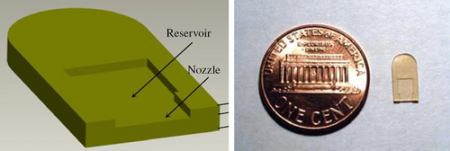May 21, 2008 feature
Toy-Like Microboat Could Carry Tiny Cargoes

As a child, Cheng Luo, an engineer from the University of Texas at Arlington, recalls playing with wooden toy boats that were propelled forward when a drop of oil was placed on the back of the boats. When the oil slid off into the water, it created lower surface tension behind the boat than in front, which pushed the boat forward. This surface-tension-based propulsion is called the Marangoni effect.
Now, Luo, an associate professor in mechanical and aerospace engineering, along with PhD student Hao Li, and post-doctoral fellow Xinchuan Liu, have taken a second look at the toy boats to see if a similar mechanism might be useful for transporting targets in microfluidics systems.
“I have a 2-year-old son. When seeing him play with toys with a big smile on his face, I often recall what I did as a kid,” Luo told PhysOrg.com. “One day, this toy boat idea came into my mind, mostly for fun at that time. Later on, after digging deeper into this idea, I realized that, in addition to serving as toys, these small boats could also have two direct applications: material supply and sensing detection. They might be used to deliver materials to a particular location in a microchannel for chemical or biological analysis, or could be applied to carry sensors through a liquid sample for detecting toxic targets.”
But with dimensions of just a few millimeters, microboats require very different design and manufacturing techniques than those used for conventional-sized boats. Researchers have investigated several microfabrication techniques for these tiny objects, although many approaches involve complicated structures and systems.
But a surface-tension-based propulsive method, like the oil-propelled boat, could offer a simpler alternative for propelling micro-sized objects. And – as the Texas researchers show in their current study – the method can offer good mobility, with the microboats reaching speeds of 30 cm per second.
“This propulsion method makes good use of the fore-and-aft surface tensions difference,” Luo said. “It only needs the addition of fuel to the reservoir of a microboat. The microboat moves on its own. As such, this method eliminates the use of any complicated systems, such as propellers, rudders, anchors, and their control systems, which are normally required in macroboats. Furthermore, it does not need any external devices to provide piezoelectric, thermal, electrostatic, or magnetostatic forces, which are commonly employed in microfluidic applications to drive fluids.”
In their study, the researchers built a simple 19.5-mg-microboat out of two layers of SU-8 polymers. Since SU-8 has a density slightly greater than that of water, surface tension plays an important role in keeping the microboat afloat. Although the microboat floats when placed on top of the water, when pressed down, it sinks due to its slightly greater density.
Using UV lithography, the engineers etched a reservoir and nozzle in the top layer of the boat for holding and dispersing isopropyl alcohol (IPA), the propellant they chose. Like oil, IPA has a much smaller surface tension than water, and also may cause less contamination than oil, making it ideal for testing.
After partially filling the microboat’s 1.49-microliter-reservoir, the researchers performed experiments in channels of water with different depths and lengths. They found that the microboat traveled faster in shallower water (for example: 1.0 second per 30 cm in a 1.0-mm depth; 1.83 seconds per 30 cm in a 9.4-mm depth).
The speed difference, the researchers explained, is partly due to greater resistance on the microboat in deeper water. Because the channel narrows toward the top, the gaps between the microboat and the channel walls become much smaller than the gap between the microboat and the bottom as the depth increases. This combination increases the microboat’s overall resistance, and makes it take longer to reach the end of the channel. Further, this increase in travel time allows more time for water to mix in with the IPA in the reservoir, diluting the “fuel” and further slowing the microboat.
The researchers also tested the microboat in a 94.5-cm-long (and 9.4-mm-deep) channel, and found that the microboat could travel 91.4 cm in 5.33 seconds. Due to an inconsistency in the long channel’s bottom surface, they did not test the microboat in shallower water. But based on the results from the 30-cm-channel, they expect that its speed would likely increase in shallow water.
Propelling microboats with this kind of surface-tension-based method could be useful in a variety of applications. As Luo explained, further studies of the microboats’ motions in microchannels could provide insight into real boats as well as microboats.
“The motions of macroboats in narrow canals and near seaports have some common points [with microboats]: the boats are moving in shallow water or near banks,” he said. “Due to the concern of experimental cost, the behaviors of large-scale ships are often explored in research labs by testing model ships, which are tens or hundreds of times smaller than their real counterparts. I am thinking of using these microboats to play some roles of the model ships. The reason behind this is simple. They are much smaller than those model ships, and thus are quite cost-effective to build and test.
“Finally, in the long run,” he added, “the successful development of these microboats should form a foundation for developing micro ‘submarines,’ and further exploring implantable micro ‘submarines,’ which would be capable of traveling in blood vessels for active drug delivery, and disease diagnosis and treatment.”
More information: Luo, Cheng; Li, Hao; and Liu, Xinchuan. “Propulsion of microboats using isopropyl alcohol as a propellant.” Journal of Micromechanics and Microengineering, 18 (2008) 067002 (6pp).
Copyright 2008 PhysOrg.com.
All rights reserved. This material may not be published, broadcast, rewritten or redistributed in whole or part without the express written permission of PhysOrg.com.





















